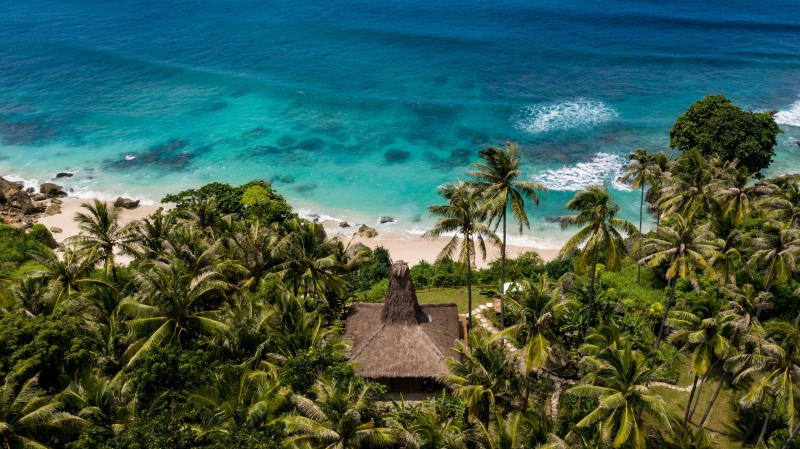Contents
The Indonesian island of Sumba offers the kind of sanctuary that travelers yearn for. A Sumba sojourn is a “change your life” kind of trip, offering a lost island forgotten in time with unspoiled beaches, rice paddy plateaus, savannah bush, and dense jungle—just an hour’s flight beyond Bali, but a world away.
Situated east of Bali within the archipelagic galaxy of Indian Ocean isles, Sumba is an ovoid, rural island—a bright emerald drop in a sapphire sea with virtually no traffic, tourist traps, or day trippers. The island is wild, in all senses of the word: from its untamed natural beauty, to the fierce pride in its culture, to its ability to challenge travelers’ expectations.
The Sumbanese way of life, in particular, is what makes this island so distinct. Most of Sumba’s residents are subsistence farmers, divided into clans that each speak a unique dialect. They live in rural villages of traditional huts with high-peaked roofs stretched up like taffy to the sky. Most people wear a medley of Western clothing and homespun ikat fabrics, harboring tucked-away scimitars, known as parangs. Many practice Marapu, an animist religion found only on Sumba centered around ancestral worship, animal sacrifice during funerals, burials in megalithic tombs, and ceremonial rites performed by shamans called ratos.
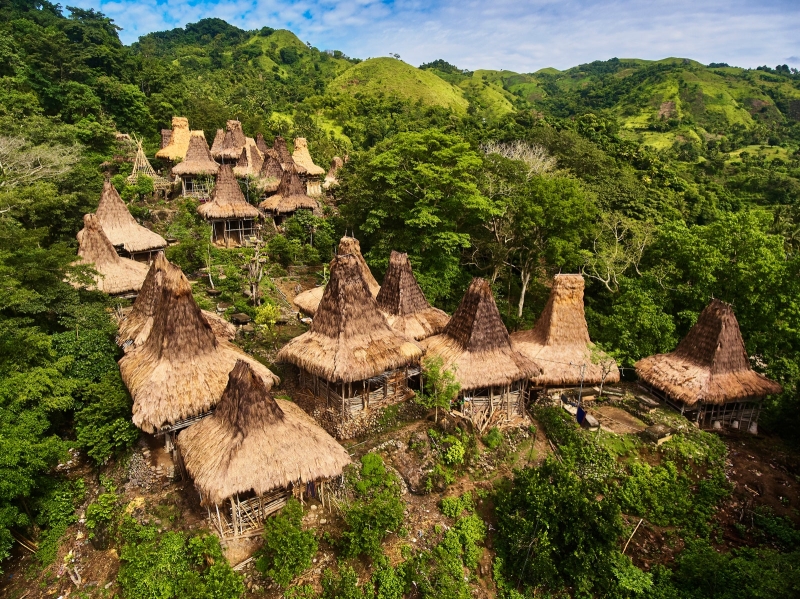
Remarkably, Sumba has managed to preserve its culture and stave off crowds, despite the pressures of tourism experienced in other parts of Indonesia. For the last century, visits to Sumba were anthropological or scientific in nature. Since the turn of the 21st century, tourism has revolved around a single, lavishly appointed property along the untouched western coast called Nihi Sumba.
But in the last year, a handful of new resorts have germinated along Sumba’s coastline, indicating there may be more development to come. With rumors that hotel chains like Four Seasons and Alila are planning to develop on Sumba, there’s no doubt it’s set to be the next major Indonesian luxury travel destination.
How to Get to Sumba
A trip to Sumba requires additional planning, as there are no international flights into Sumba nor direct flights from America to Indonesia. The only way to visit Sumba is to fly via Bali, despite Sumba’s close proximity to northern Australia. The one-hour scenic flight glides past Lombok and Sumbawa islands, with Komodo to the north in the distance. While intrepid travelers can venture independently to Sumba, Scott Dunn employs well-traveled experts who can assemble a seamlessly executed itinerary that removes any stress from travel. The main airport, Tambolaka, is rinky-dink at best—so travel arranged through an agency is recommended.
“Something we really pride ourselves in is making our guests’ travel as seamless as possible, and really just taking any stress out of travel to Sumba,” Scott Dunn’s Asia Expert Lili LeBaron shared with Vogue. Scott Dunn’s 24/7 services in Sumba include well-rounded itineraries with contacts on the ground, local guides, and more.
Where to Stay in Sumba
Nihi Sumba
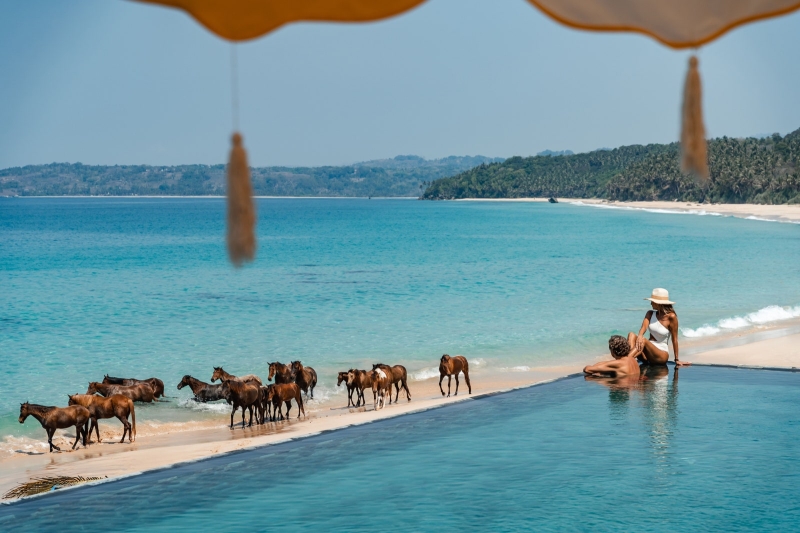
The top resort on Sumba is the iconic Nihi Sumba. Run by hotelier James McBride and owner Chris Burch, NIHI Sumba creates magic from the raw landscape, transforming rice paddies into luxury nirvanas, a sea mist-shrouded coastline into a destination spa, and teak forests into eco-luxe villas. Located on the remote Nihiwatu Beach, Nihi Sumba is perhaps most impressive for what it has not done; the hotel has resisted the temptation of construction, affording guests privacy within villas set among the tropical wilderness with views of the sea. “The greatest luxury here is where you have a two-and-a-half kilometer beach, and you may see Sumbanese children washing their buffalo, a couple taking a walk, or someone galloping a horse down the beach,” McBride told Vogue. “That enjoyment is extraordinary. Where else can you find that in the world?”
From the moment of arrival in Sumba, NIHI Sumba’s safari vehicle whisks travelers on the exhilarating 1.5-hour drive traversing north to south, passing buffaloes, Sumbanese ponies, taro root roadside vendors, and villages with oblong huts made of corrugated metal. The adventurous ride through the island’s lush heartland smells of fresh earthy petrichor and wood-burning fire, and it’s not uncommon to pass funeral ceremonies with sacrificial livestock. The cold young coconuts and banana leaf-wrapped cakes prepared by Nihi Sumba make the multi-microclimate transfer all the more palatable.
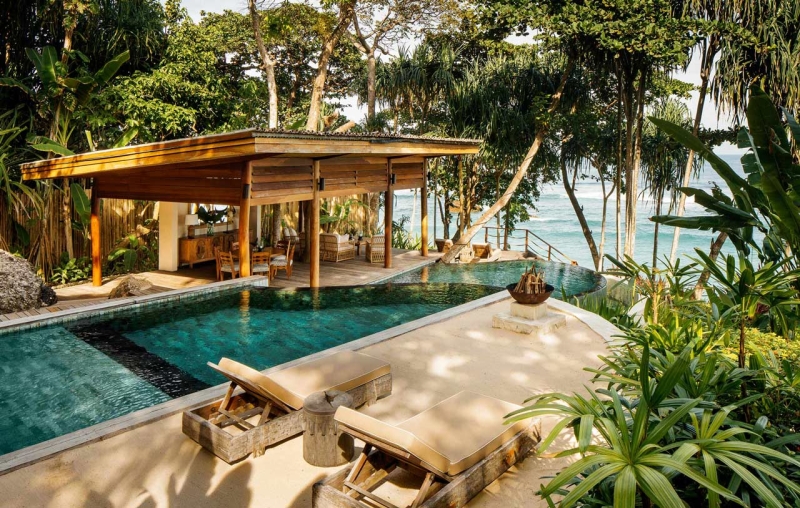
Nihi Sumba is for the adventurous traveler who finds comfort in luxury. The activity-driven property has no shortage of riveting pursuits: surfing, horseback riding, padel, pickleball, spearfishing, and trekking through deciduous forests, to name a few. But for the traveler who prefers serenity over adrenaline, the resort’s spa delivers indulgence in a wabi-sabi setting. Detached from the main resort and accessible via horseback, trek, or safari vehicle, Nihi Sumba’s “spa safari” makes the most of its natural surroundings: waves crash against coconut husk-strewn coral coves, and one can smell the sea while enjoying a scrub, massage, or facial using oils derived from ingredients found across the island. Sensory catharsis at Nihi Sumba’s spa may also include meditative rice planting, a foot rub under an open-air bale, or connective breathwork with a Sumba pony.
Book NowCap Karoso
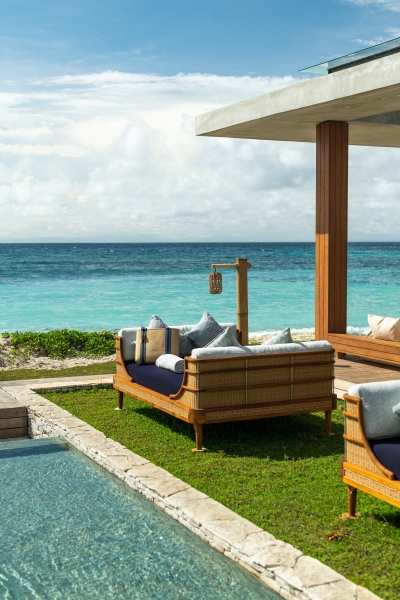
In the last few years, a new wave of hotels has arrived in Sumba, offering tasteful design and crowdless beaches for a traveler fatigued by Bali’s congestion. The standout newcomer is Cap Karoso, a contemporary beach resort on Sumba’s sunny southwest coast offering seashore R&R with French flair. Founded in 2023 by Fabrice and Eve Ivara, Cap Karoso’s setting exhibits a quiet side of Sumba, nestled at the edge of dry savannah where corn fields and cashew trees greet milky, moody sunsets. “When you come here, you feel that it’s another time in a different world,” Eve Ivara told Vogue. “It’s just completely cut off from everyday life and feels really untouched. You have the feeling of getting close to a different culture and different way of living, which is pure and not touristy. I think that’s a treasure nowadays.”
Cap Karoso’s standout characteristic is its design. With a background working in fashion marketing at LVMH, Ivara chose to design the architecture of the property with a style she calls “modernist with a hint of brutalist.” While many of the materials are sourced within Indonesia, the look has a decisively European sensibility. Villas are more Scorpios than Seminyak, where private pools and an indoor-outdoor mentality resemble a resplendent residence one might find in Palm Springs or Formentera. All living spaces are accessorized with wicker and wood, statues and ceramics, and cement and stone. The textures make the architecture sing: ochre stones, singed banana leaves, knotted rugs, cyan tiles, and rope-strung chairs mean there’s no such thing as a bad photo across the property.
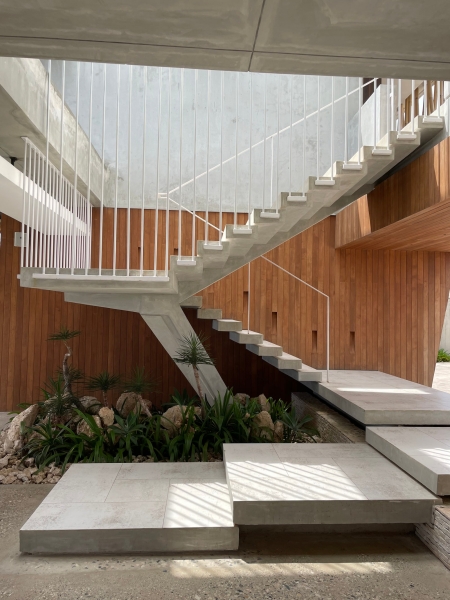
Wend your way through the sandy pathways—which criss-cross a maze of guava trees, sea hibiscus, and whizzing dragonflies—and you’ll arrive at Cap Karoso’s fine dining eatery Julang. Serving dinner across a long communal table jutting out from an open kitchen, it’s not uncommon to be seated next to sophisticated diners from Brooklyn, Canggu, or Lyon. Every month or two, a rotating chef visits from Europe to serve a bold tasting menu with ingredients fresh from the hotel’s organic farm. Most recently, Top Chef alumnus Baptiste Trudel has been cooking with locally sourced roselle flowers, freshly caught octopus, passion fruit, and farmed pak choy. The rotational chef is part of Cap Karoso’s cultural and experimental ethos, in which visiting tastemakers in food, music, and the arts are all invited to leave their mark on the hotel.
Book Now
What to Do in Sumba
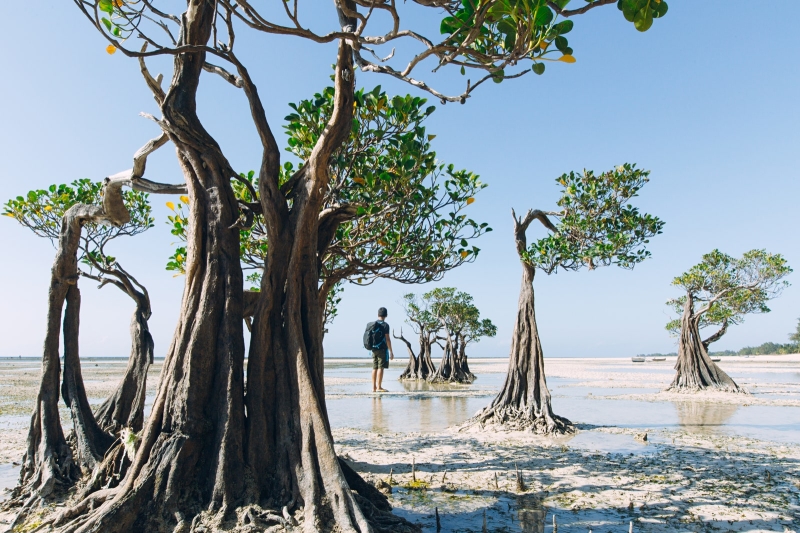
Given Sumba’s undeveloped tourism sector, there are no major tourist sights or restaurants. Hotels can arrange outdoor excursions like e-bike tours, horseback riding, waterfall hikes, swims in Weekuri Lagoon, or tours of traditional villages. Visits to centuries-old Sumbanese villages are the best and most respectful way to experience the island’s untampered culture, offering the opportunity connect with locals, understand how ikats are woven, and try chewing the analgesic betel nut that reddens the mouths and lightens the minds of villagers. Aside from the occasional roadside warung, dining in Sumba revolves around its hotels.
While in Sumba, you’ll want to get out on the water—and riding Occy’s Left is the ultimate surfer’s flex, known as one of the world’s most coveted and enviable waves. It propels consistently perfect swells that carry surfers several hundred meters towards Nihiwatu Beach, and is limited to only 12 surfers per day. Nihi Sumba offers white glove surfing, ferrying surfers via jet ski to the front of the left-leaning wave after each barrel ride.
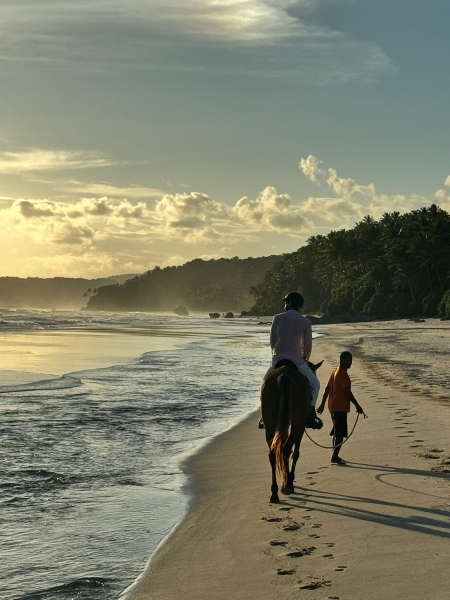
The most recommended experience on Sumba is Nihi Sumba’s Wild Wellness retreats, immersive escapes that grant liberation from noisy reality. These are not woo-woo wellness retreats that deprive or set unrealistic expectations. Instead, Wild Wellness promotes pushing participants outside their comfort zones with novel well-being treatments and instinctual connections. On a Wild Wellness retreat, guests may participate in equine therapy, an ocean swim with Sumbanese ponies, underwater rock running, silent disco dancing with Sanctum, or an afternoon of spa treatments. Wild Wellness is an out-of-body experience certain to leave guests stronger, healthier, and more appreciative.
To leave the island a little better than when they arrived, visitors can volunteer with and donate to the Sumba Foundation, making a trip to Sumba an altruistic vacation they feel good about. The Sumba Foundation’s mission revolves around supporting Sumbanese people, with projects ranging from fighting malnutrition, providing villages with potable water, eradicating malaria, and setting up locals with professional skills. Additionally, visitors can stay at Maringi or dine at Makan Dulu, two hospitality projects by the Sumba Hospitality Foundation, a hospitality school in Sumba that funnels graduates into the burgeoning hotel scene in Sumba or further afield throughout Indonesia.
What to Shop for in Sumba
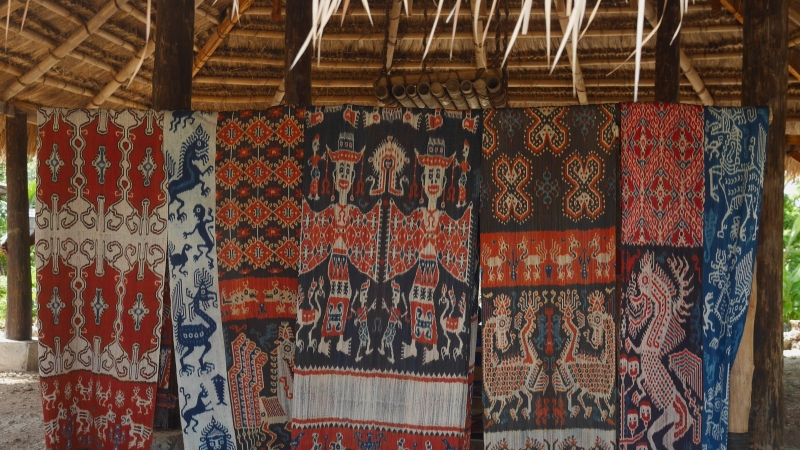
Sumba does not have a thriving shopping scene like Bali, but it does have authentically handwoven ikats. These gorgeous textiles take several months to craft, and are made of yarns dyed with natural materials like wood bark and indigo. They are traditionally handmade by Sumbanese women on looms for weddings and funerals, but can translate back at home as wall hangings, table runners, or colorful throws. Ikats from western Sumba tend to be simpler and striped, while ikats from eastern Sumba tend to exhibit more complex motifs with animals or people. They can be purchased at hotels or in Waingapu’s town markets. Nihi Sumba’s boutique, curated by retail expert Karen McBride, partners with a collective of local women called Karaja Sumba to source traditional ikats, as well as creatively repurposed ikats into fashionable garments and totes.
Another collectible to bring home is something from a new Sumbanese beauty line called Wallacea Skin, created under the guidance of pharmacognosist Dr. Simon Jackson. The brand empowers local communities by teaching them regenerative farming techniques to cultivate indigenous ingredients, then buys them to create sustainably sourced cosmetics. Wallacea Skin can be purchased at Nihi Sumba, including its moisturizing oil infused with seven Sumba plants: ginger, galangal, coriander seed, turmeric, mangosteen skin, cinnamon, and betel nut.

